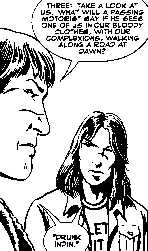Home |
Contents |
Photos |
News |
Reviews |
Store |
Forum |
ICI |
Educators |
Fans |
Contests |
Help |
FAQ |
Info


Peace Party #1
Review by Lori Fuller
 As a longtime fan of comics, I was thrilled to hear about the publishing of a comic book for and about Native Americans. The possibilities for such a thing are endless. Could it be superheroes? Perhaps kids out looking for something to do? Is it going to be more spiritual, or more political? Are kids going to like it?
As a longtime fan of comics, I was thrilled to hear about the publishing of a comic book for and about Native Americans. The possibilities for such a thing are endless. Could it be superheroes? Perhaps kids out looking for something to do? Is it going to be more spiritual, or more political? Are kids going to like it?
Yet when looking over a copy of Peace Party, I was both thrilled about the start and bored about the execution. Granted, it's the first issue, and there is no way to tell the whole story in one issue. But usually there's some form of character development and a simple topic for the first issue; the nitty-gritty of the series comes later. And sadly, I read more about the characters in this issue in an article from another publication than I did in the comic itself.
With Peace Party, the story delves deep into the Pueblo regions of the southwestern United States. Its main characters, presumably Hopi or Navajo, are young guys who start off goofing around a campfire. With a major car crash and a vision, they're thrown into the main plot of the comic—a violent dispute about the Black Mesa mining situation and the Hopi water rights. The comic proceeds on from that point with some oddball twists and turns, some Native superpowers, and similar comic-book traits.
Ron Fattoruso and Mike Kelleher do the artwork, and are both very familiar with the field of comic book art. Veteran comic letterer Kurt Hathaway, whose work is well known in the realm of illustration, does the lettering. Overall, these folks did their normal fantastic work with Peace Party.
Because it was a first issue, there were some errors. The plot box promoting the next issue should have been at the end of the last strip. There was an overflow of non-illustrated sideline articles on everything from the Sacagawea coin to a page on multicultural perspective. It occurred to me that much of the excess information that was scattered throughout the issue was unneeded, redundant, or was implied in the whole essence of the comic itself.
Bizarrely, there was an article on Black Mesa and part of an article (referencing a non-existent page) on llama in the middle of the comic section, completely disrupting the reading experience. And while the high quality paper used for the comic book is nice, one wonders if the money would be better spent on colorizing the artwork itself to make it more visually appealing to younger readers.
The History Page was on a topic completely off-kilter to the issue at hand. While it was a fascinating treatise on the newspaper follow-ups after the original Wounded Knee Massacre, it had no bearing on the current issue. I would enjoy seeing more pieces like that, but is a comic geared toward children the place for such things?
Sadly, there was very little in Peace Party that actually was aimed at children under the age of seventeen. Adults comics are not unknown in the genre, but after reading this issue, the choice of such a politically charged place to start seems strange and might put off readers who are not politically active. And it has been described as "a smart person's comic book." Does this mean that it will go beyond the understanding of kids who may not be familiar with current Native American issues?
While I do not suggest that the comic book be "dumbed down" in any way, more consideration needs to be put into making the comic easy to read. Also should be given to the graphics layout of the commentary and letters pages. The present layout makes it difficult to read, and the lack of any visual excitement likely will reduce the number of readers of that section.
All these comments are about a first issue of a comic book—very much a prototype of future issues, and a learning experience for many involved. Likely, most of the problems in this issue will soon be corrected, if not already. And it is interesting to note that you can subscribe to this comic book for delivery to your home, thus avoiding the difficulties in perhaps finding a comic book store that carries it. This is a major plus for those of us who follow a comic series for years!
Overall, the comic is good; the art well executed, the aims of the publisher and writer high. But the folks involved in the comic need to sit down and talk about whom their comic is aimed at, what it should be about, and who the characters really are. Without these aspects, the comic will fall short of what it could be—an amazing learning experience for both Native and non-Native kids and their parents.
Responses
Respond to this reviewer
Rob's reply
* More opinions *
|
|
. . .
|

|
Home |
Contents |
Photos |
News |
Reviews |
Store |
Forum |
ICI |
Educators |
Fans |
Contests |
Help |
FAQ |
Info
All material © copyright its original owners, except where noted.
Original text and pictures © copyright 2007 by Robert Schmidt.
Copyrighted material is posted under the Fair Use provision of the Copyright Act,
which allows copying for nonprofit educational uses including criticism and commentary.
Comments sent to the publisher become the property of Blue Corn Comics
and may be used in other postings without permission.
 As a longtime fan of comics, I was thrilled to hear about the publishing of a comic book for and about Native Americans. The possibilities for such a thing are endless. Could it be superheroes? Perhaps kids out looking for something to do? Is it going to be more spiritual, or more political? Are kids going to like it?
As a longtime fan of comics, I was thrilled to hear about the publishing of a comic book for and about Native Americans. The possibilities for such a thing are endless. Could it be superheroes? Perhaps kids out looking for something to do? Is it going to be more spiritual, or more political? Are kids going to like it?